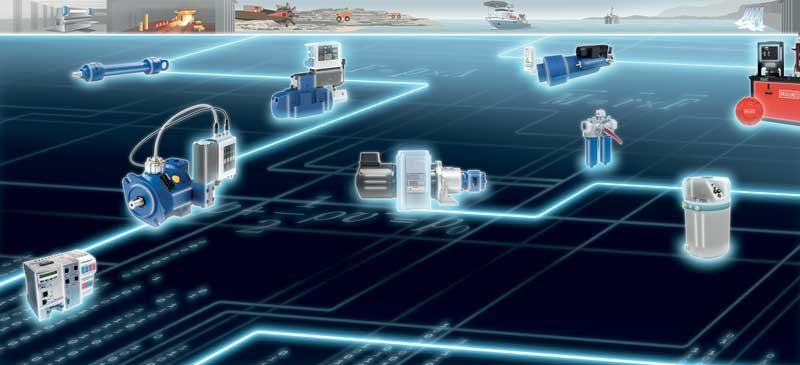The Factories in the Time of Interconnected Hydraulics
Today, hydraulics is facing a huge series of transformations that are making valves and pumps more and more intelligent and able to communicate with the outside, increasingly more precise and efficient from an energy point of view, and ever smaller and simpler to install. All this without losing power and capacity.
di Leonardo Albino
According to Riccardo Patat, Bosch Rexroth’s Sales Product Manager for Industrial Hydraulics, “Within a few years any component coming out of the Bosch Rexroth factories will be able to connect with the outside world and transmit data. The pumps, cylinders, valves and motors made by Bosch Rexroth began this transformation several years ago and today they can provide the market with more than 200 years of experience in power management, together with state of the art IoT for mechanics”. The hydraulic cylinder global market was valued at $12.98 billion in 2016 and is expected to reach $19.30 billion by 2023, with an annual compound growth rate of 5.95% between 2017 and 2023. The market for hydraulic pumps should reach $10.4 billion by 2022, with a compound annual growth rate of 4.7% during the 2016-2022 forecast period.
The era of digital hydraulics
In recent years Bosch Rexroth has tried to combine the two technologies to get the best of both. In the last 25 years engineers have focused on “remoting” the intelligence of each individual component, thereby controlling power by adapting it to the required level and allowing high precision, keeping the same performances when operational conditions change, reducing noise, and providing information on the health of the component and on the need for maintenance to avoid machine downtime. In an ideal world where everything can be created from scratch, this revolution is in itself simple to achieve: already today it is possible to create an ex-novo system containing only “smart” components which can communicate with each other and with a central computer. It is possible to store data in Cloud and make them available to an operator tens of thousands of kilometres away.
From “Big Data” to “Smart Data”
“That’s why, for example – adds Mr Patat from Bosch Rexroth – we focused on creating multi-Ethernet valves with pre-set libraries that could allow real-time connection, but at the same time were equipped with a system of open communication integrated in all the production layouts, and could be configured with the different machines already present. The market response, especially in Italy, is amazing: only 3 years ago, not even 1% of our customers were asking us for these solutions. And it is a trend which sees Italy ahead of Germany and which could allow our country to gain a competitive advantage”.
The really important question is then: What is the use of this data? What can I do with this information? How can I benefit from it?
One of the very first application fields, as well as one of the most important, is maintenance optimisation. By correctly processing the data, it is possible not only to carry out the checks at fixed intervals, which are rarely at the optimal time, but also to plan the repairs on request or in advance, ordering in advance the components to be replaced when necessary: a well-designed algorithm will be able “on its own” to draw the right conclusions from the available data. Bosch Rexroth is capable to deliver predictive maintenance, which is already a fast and reliable reality: it is exactly the combination of experience in IoT, product know-how and the related applications that allows us to turn “Big Data” into “Smart Data”.
Some practical cases: the proportional valve and the pressure switch
Today, Bosch Rexroth is extending the advantages of the IO-Link open standard to proportional valves and sensors for hydraulics. The IO-Link is supported by around 150 companies and enables digital communication between peripherals and the control unit, in parallel with the usual field buses. Using proportional valves and pressure switches, Bosch Rexroth is integrating valves and sensors for hydraulics into the network for the first time: in this way it is enabling the integration of fluid engineering into Industry 4.0 applications; the IO-Link standard, in fact, allows the various components to be connected vertically, up to the level of the IT systems.
In addition, the IO-Link allows standardised and simpler wiring, thanks to the use of standard unshielded wires (M12 connectors). Remote access on the component makes it possible to evaluate the system conditions, such as temperature, pressure, operating hours and error status. Everything can be done without interrupting production, allowing for predictive maintenance: The system locates and displays all the various devices and their respective assistance requirements. In addition, thanks to the IO-Link standard, devices can also be replaced by personnel without specific training. The various components are clearly identified using a location ID and electronic label, allowing easy replacement of the interchangeable components.
From the compact and smart unit to the efficient and sturdy pump
The newly designed CytroPac hydraulic unit from Bosch Rexroth, in addition to integrating all the hydraulic and electrical components in a very small space, is already completely wired with pressure, temperature and level sensors and a filter clogging indicator. The integrated frequency converter provides all the data to the machine control via a Multi-Ethernet interface which, thanks to the constant detection of operating states, allows the user to quickly identify any wear phenomena or malfunctions and intervene quickly to resolve them. Efficiency and reliability are the main reasons that drive the biggest manufacturers of presses to choose the A4VSO pump, which offers unparalleled precision and continuity of operation. Thanks to its robustness and high level of efficiency, they are achieving the best results in the sector. The pump allows variable flow control and offers excellent rapid response and control properties.

